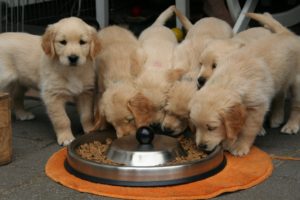
The gut microbiota has a big influence on the physical and mental health of all living creatures, and changes within the microbiota can bring about changes in a creature’s health. There are several complex factors that can alter an animal’s microbiota, for instance diet, stress and even who they live closely with.
 Luis Pedro Coelho and his colleagues at the European Molecular Biology Laboratory, in collaboration with Nestlé Research, studied the gut microbiome (the genetic material belonging to the microbiota) of beagles and retrievers. They found not only extensive similarities with other dog breeds but also with the human gut microbiome. Furthermore, our gut microbiome is more similar to the dog gut microbiome than those of pigs or mice – two organisms used frequently in model studies.
Luis Pedro Coelho and his colleagues at the European Molecular Biology Laboratory, in collaboration with Nestlé Research, studied the gut microbiome (the genetic material belonging to the microbiota) of beagles and retrievers. They found not only extensive similarities with other dog breeds but also with the human gut microbiome. Furthermore, our gut microbiome is more similar to the dog gut microbiome than those of pigs or mice – two organisms used frequently in model studies.
We found many similarities between the gene content of the human and dog gut microbiome. The results of this comparison suggest that we are more similar to man’s best friend than we originally thought.
Speaking of the discovery, Luis Pedro Coelho says: “We found many similarities between the gene content of the human and dog gut microbiome. The results of this comparison suggest that we are more similar to man’s best friend than we originally thought.”
Dogs were the first animals to be domesticated by humans, and we have frequently shared food resources and living quarters with our ‘best friends’ throughout history. Unsurprisingly, these factors would have contributed to our gut microbiota developing along similar lines.
 The similarities do not end there. Obesity in dogs is a real concern for their owners, and Dr Coelho’s team looked at how the dog gut microbiome changed in response to dietary interventions. By introducing a high protein-low carbohydrate diet to sets of overweight and lean dogs, they found the gut microbiome changed significantly only in overweight dogs, implying the microbiome in lean dogs is far more robust. This has been seen in human studies too. As fecal microbiota transplants – taking fecal microbiota from healthy individuals and transplanting them into patients with certain illnesses – have shown positive results in humans, could the same procedure be used potentially to overcome obesity (to some degree) in dogs?
The similarities do not end there. Obesity in dogs is a real concern for their owners, and Dr Coelho’s team looked at how the dog gut microbiome changed in response to dietary interventions. By introducing a high protein-low carbohydrate diet to sets of overweight and lean dogs, they found the gut microbiome changed significantly only in overweight dogs, implying the microbiome in lean dogs is far more robust. This has been seen in human studies too. As fecal microbiota transplants – taking fecal microbiota from healthy individuals and transplanting them into patients with certain illnesses – have shown positive results in humans, could the same procedure be used potentially to overcome obesity (to some degree) in dogs?
These findings suggest that dogs could be a better model for nutrition studies than pigs or mice and we could potentially use data from dogs to study the impact of diet on gut microbiota in humans, and humans could be a good model to study the nutrition of dogs.
There are important implications and applications that extend from the discoveries of Dr Coelho and his colleagues. One of which is using the dog as a model for human gut microbiome studies and vice versa, as Dr Coelho explains: “These findings suggest that dogs could be a better model for nutrition studies than pigs or mice and we could potentially use data from dogs to study the impact of diet on gut microbiota in humans, and humans could be a good model to study the nutrition of dogs.”
Personally, I find the implication of using humans as a model for predicting dog gut microbiome behavior intriguing because normally scientists use animals as models for what could happen in humans, for example in genetic experiments or drug development. Therefore, the idea that we can be the model organism is novel.
To conclude, Dr Coelho’s team provide us with interesting correlations between the dog and human microbiome, but a great deal more investigation needs to occur before we can apply this knowledge extensively. To aid reproducibility and encourage further work, the team have published the software associated with their findings to Code Ocean, which means you can run it directly from their published article in Microbiome.
- Scientists of the future: Matteo Gregori discusses his research path into Arctic microbiology - 22nd February 2022
- Scientists of the Future: Rebecca Ansorge talks to us about her research on the gut microbiome - 10th February 2022
- Quiz: so you think you know biology? - 6th October 2018
Comments